Professor of religion Alyssa Maldonado-Estrada says that growing up in New York City she was always fascinated by street fairs. “There’s just a certain sort of magic about them,” she says. “You’re walking down the street, thinking it’s just a normal day, and all of a sudden you happen upon a saint’s procession or celebration. There are tents, special foods, special smells, and people occupying the street in a way that they don’t normally do.”

Later, as a scholar of religion, Maldonado-Estrada became interested in how these festivals are a way of expressing religious and ethnic identity and how “feasts and saints’ days are a way to reclaim neighborhoods.” She started focusing her work on one festival in particular: the feast of Our Lady of Mount Carmel in Williamsburg, Brooklyn.
Maldonado-Estrada spent a total of six years not only attending the festival, but also spending time with the community of men responsible for preparing for the feast. The eventual result was her new book, Lifeblood of the Parish (New York University Press), where she argues that paying attention to this behind-the-scenes work sheds new light on how men understand their spirituality and relationship with God, the church, and one another.
Tell us a little about the feast of Our Lady of Mount Carmel and how it’s celebrated in New York City.
For almost two weeks in July, the Shrine Church of Our Lady of Mount Carmel (OLMC) in Williamsburg, Brooklyn holds a street festival to celebrate the feast of Our Lady of Mount Carmel along with Masses, processions, and novenas.
The feast of Our Lady of Mount Carmel is probably one of the most spectacular and grand saint’s day celebrations in New York City. I would say the whole thing feels very old New York. Today, there’s sometimes a funny juxtaposition with the Brooklyn brunch crowd.
The streets near the parish are lined with food stands, and the air is heavy with the smell of zeppoles, sausage, and peppers. There are also carnival games and rides: a Ferris wheel and all sorts of other things you can do on the street. Inside the church, in the lower hall, they have a café and flea market. And next to the church there is a shrine for Our Lady of Mount Carmel. During the feast, people will visit the shrine to light candles, to get scapulars, to leave a petition, or to kneel in prayer. And then on July 16, her feast day, there is a beautiful procession through the neighborhood, including a float decked with flowers.
The most dramatic part of the festival is the dance of the Giglio. The Giglio is this enormous, heavy, tapered tower: It weighs four tons and is about 65 feet tall. It’s often decorated with arches and columns, handcrafted saints, or flying angels. The latest design had a kind of larger-than-life rosary and a risen Christ. Men in the community lift the Giglio on their shoulders and dance it through the streets around the parish. They literally lift this four-ton tower and bounce it through the streets. There’s a full brass band that rides on top of the Giglio, as does the pastor of the church. It’s so interesting to see the way the Giglio and the entire dance contrast with the architecture and the aesthetics of super gentrified, trendy Williamsburg.
Where did the Giglio come from?
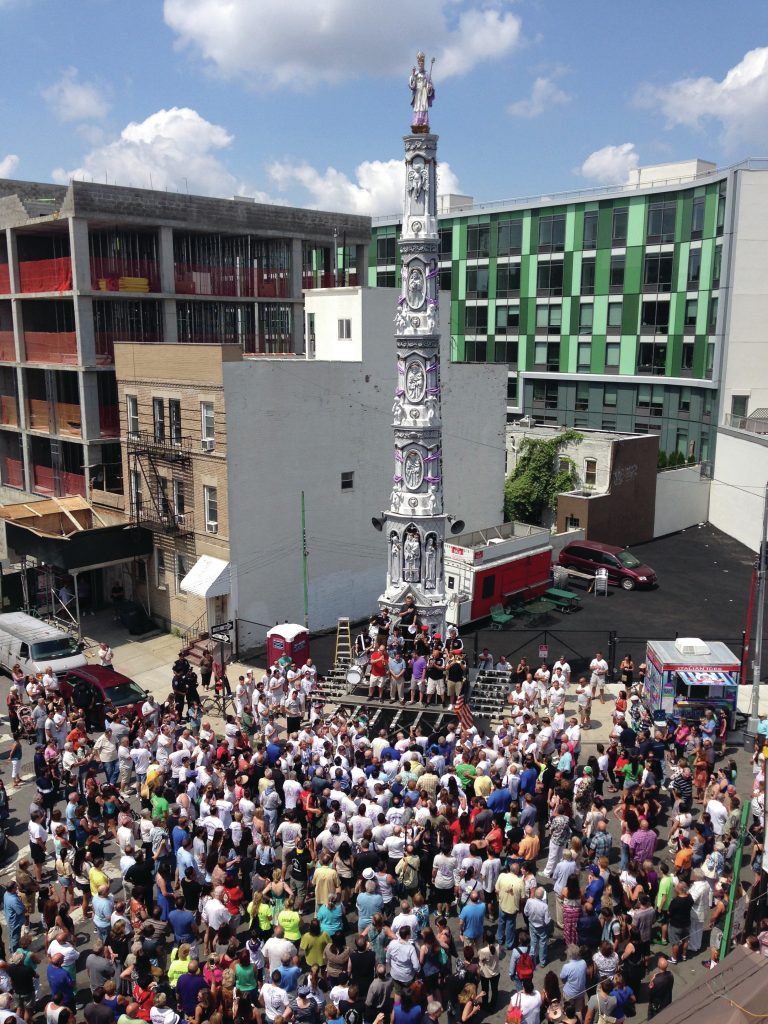
Since the 1950s, the parish has celebrated the feast of Our Lady of Mount Carmel together with the feast of St. Paulinus, a fifth-century bishop and the patron saint of Nola, a small town outside of Naples in the Campania region of southern Italy. The Giglio serves as a kind of hagiographical drama that reenacts and commemorates St. Paulinus’ self-sacrifice in order to save Nola.
While the details of the story have changed throughout history, the story goes that in the fifth century the Vandals invaded Nola. They took Nolanis captive and brought them to the Vandal kingdom. St. Paulinus worked as hard as he could to gather ransoms for all these captives, but he couldn’t save them all. So, when a widow’s son was taken captive, St. Paulinus offered himself in exchange and went to work in the Vandal kingdom. Eventually, his master found out he was a bishop and was so moved by his act of courage and self-sacrifice that he sent St. Paulinus sailing back to Nola, along with other freed captives.
The people of Nola were so happy to have their loved ones back that they met St. Paulinus’ boat on the shore carrying towers of lilies—gigli in Italian. And so during the feast these men lift the Giglio as if they were lifting these towers of lilies.
Do men have any other roles in the festival beyond carrying the Giglio?
Along with the Giglio tower, the community also creates a boat to commemorate St. Paulinus’ ship. Most often, this is an actual boat that includes woven waves and a sail. The boat is lifted and carried through the streets.
On the boat rides the figure of the Turk—supposedly the one who delivered St. Paulinus back to his hometown. Getting to play this figure is considered a great position of honor in the community. The Turk dresses up in great dramatic fashion, often in rhinestones and lamé and often with a turban.
Together, the Giglio and the Turk allow men to try on different aesthetics. If what we see under the Giglio is men wearing matching T-shirts and cargo shorts carrying this structure and relying on their brute strength, the Turk offers a different, more over-the-top, flamboyant aesthetic.
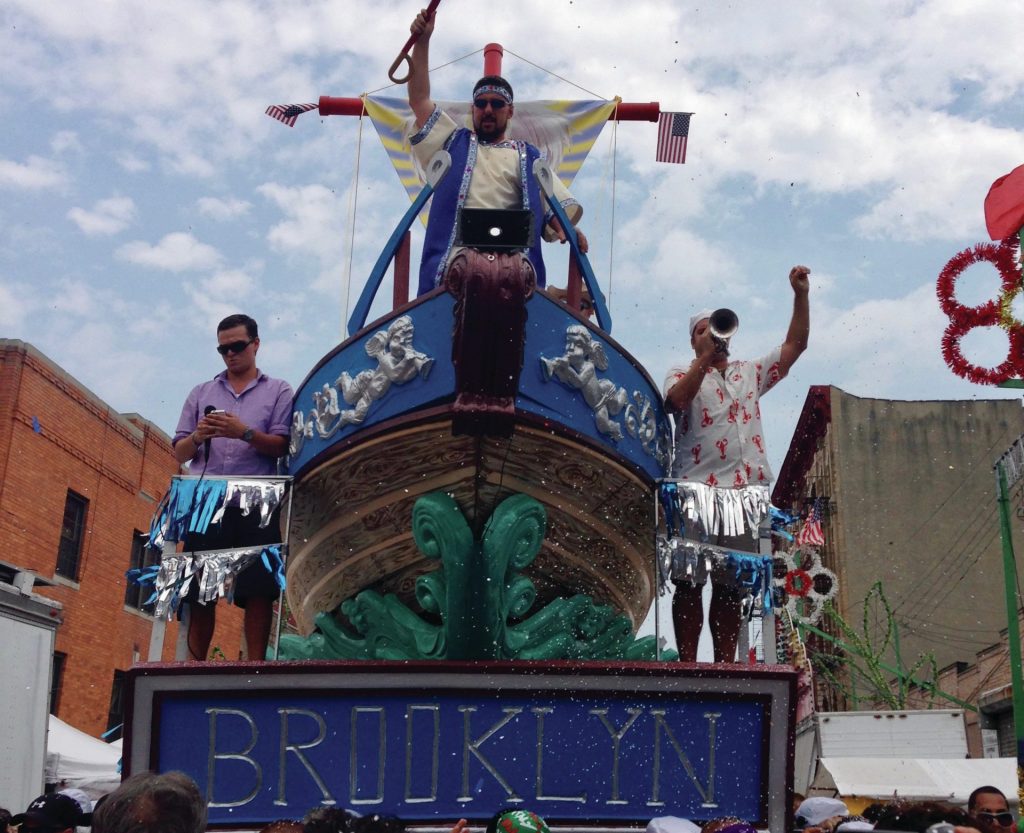
Is participating in the Giglio an expression of faith for these men?
In this community, everything men do is part of keeping this church and community alive. They understand themselves as bearers of tradition. Sometimes they enact their Catholicism in ways that may seem unorthodox or maybe a little irreverent, but it’s all part and parcel of how they feel themselves to be connected to the saints, the parish, and the broader history.
I didn’t find a lot of God talk among the men in this community. If you ask them, “Why do you do this? Why do you lift the Giglio?” you often get a stock answer: “Oh, this is about penance,” for example. I think this goes back to them knowing what it’s like to have a lot of publicity.
So it wasn’t always through interviews or questions that I could tell anything about how this experience affected these men’s faith or relationship with the church. I think this is so important: If we just look at what people say, we miss a lot. Instead, we have to look at what people do. That’s the biggest lesson I learned from the men at OLMC.
For these men, their love of the parish and of one another is inseparable from their relationship with God. I think so much of what I saw could be understood through the lens of this beautiful, intense love for Catholic tradition. And that was all bound up with their family bonds, their ethnic identity, and their connection to the neighborhood itself. These men are staunchly committed to keeping a Catholic presence in the neighborhood, even if they don’t necessarily talk about God all the time.
Everyone I talked to had different ideas about what it means to be a good Catholic. It’s not always about going to church every Sunday. One guy told me, “As long as you do good for others and give a lot to the parish, I think you’re a good Catholic.” He didn’t necessarily mean giving in terms of money: He meant leveraging whatever skills you have for the good of the church. So everything these men do—whether it’s participating in the Giglio or the other work that gets done throughout the year such as painting, fundraising, or other volunteer work—all of that is part of living out your faith. It all falls under the framework of: Everything we do, we do for God, the parish, and the memory of our ancestors.
Do the men mark these important relationships in any other way beyond their participation in the Giglio?
When you see the men under the Giglio, one of the first things you notice is all of their tattoos: Their bodies are marked with the iconography and insignia of Catholicism. Tattoos of rosaries, the saints, even the Knights of Columbus—their bodies are a map of their Catholic identity and devotion.
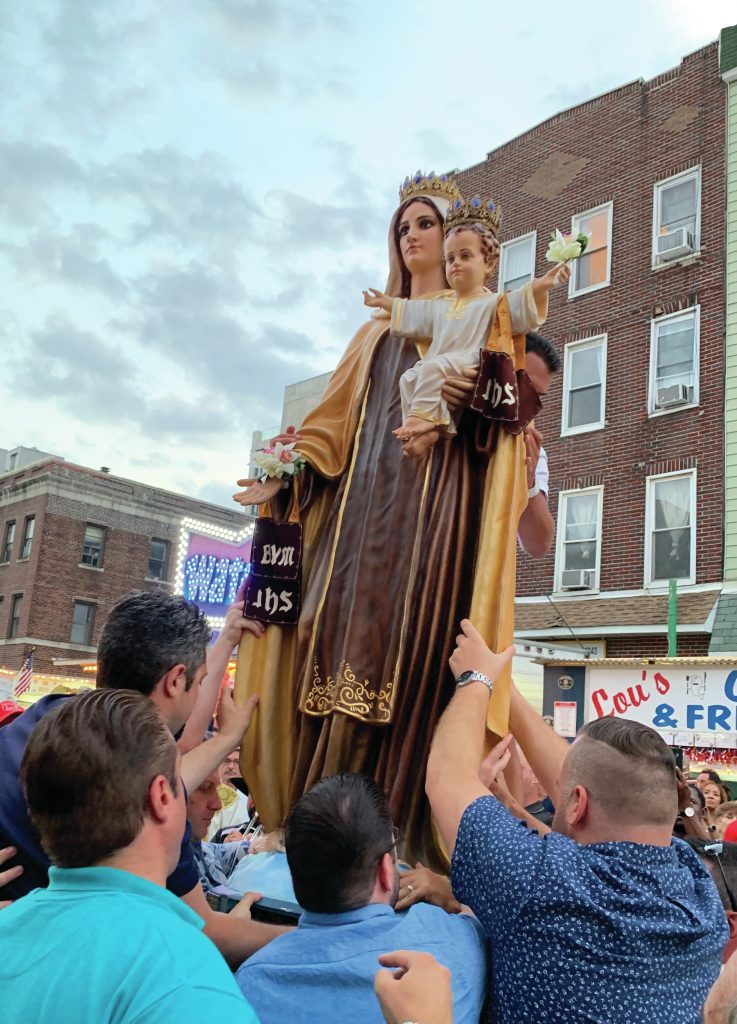
One thing that’s different about these tattoos is that they are not just individualizing marks. We often think about tattoos through the lens of aesthetics or as exteriorizing an inner self. So when I asked the men why they had these tattoos, I expected stories about individual devotion. But that’s not what I got.
Instead, I heard stories about men working in the basement together, creating the Giglio. Many of them had the first Giglio they worked on tattooed. These stories were not about themselves or their individual beliefs but about making moldings out of chicken wire, painting things or choosing colors, or just working together. Through these tattoos I came to realize the kinds of bonds the men are forming through their work. The tattoos show the permanence of these bonds.
Why do you think the men mark the significance of this experience through tattoos?
Tattoos literally materialize the fact that everything in this community is about time, labor, and lifelong effort. They’re located on people’s arms and legs, the literal body parts that enable these men to lift the Giglio. They allow men to write themselves into feast and parish history. But I also think tattoos are sacramental. They’re not just a drawing on the skin that these men can do and then forget about: They mediate and channel a certain presence and a certain power.
For example, one of the men I worked with, Joe, has a tattoo of Our Lady of Mount Carmel on his forearm. When I asked him about it, he told me how he used to work in a hospital and wasn’t allowed to wear his scapular to work because of germs, etc. But he couldn’t bear not having Our Lady of Mount Carmel close to him. So instead of the physical object, he got a tattoo.
There are so many ways in which tattoos channel certain forms of grace. The ability to touch and be touched by the divine, to hold and carry these tattoos—tattoos function very much like holy or devotional objects. They’re actively worn and displayed, and they promise this ongoing closeness between men and the saints, the Virgin, or whoever is represented.
If in the past people left wax limbs or tin and silver body parts at a shrine or chapel to give thanks to a saint for intercession and healing, I think today that relationship might be flipped. Instead of giving body parts, Catholics are placing the saints on their very bodies to achieve a feeling of closeness, exchange, and tactility with these holy figures.
Is how these men act out their relationship with God consistent with typical descriptions of male spirituality?
Catholic scholarship often describes laymen as not very spiritual or devotional at all. We hear so many stories about laywomen as pious, as socializing children, as the ones who are more likely to pray. When we look at demographic data historians have found that men have lower rates of Mass attendance, are less likely to go to confession, and are less likely to pray on a daily basis.
People have often thought about devotion as something that is personal, as something domestic that maybe takes place at a home altar, as something that is wrapped up with ideas about suffering or tenderness. But, again, what I learned from these men is that we can’t necessarily assume what Catholic practice looks like. Spending time with these laymen and where they spend their time shows us different kinds of spaces and activities that they make meaningful and find devotional.
What I found is that service really matters to these men. As does labor, and labor in quantifiable terms: how many hours, days, and years someone has spent helping the parish or working on the Giglio. Men do their devotion together: They build these intense bonds and friendships within Catholic communities, and they enact their spiritual identities in community.
I think that men’s religious lives develop in different contexts and in different places. But all of these sites are very important and draw generations of men to parish life.
In many ways this feast community offers a stable route to achieving “manhood” and to having certain forms of authority within the parish. This stability is contingent upon men constantly having to put in so much effort and labor, yet there is something so sticky and binding about what is going on at OLMC. I think this has to do with the relationships that the men form: They are deeply connected to one another, they spend so much time together, they tell stories about their mentors, they get tattoos to honor their time together.
Catholic communities provide men spaces for friendship, for meaningful labor, and for them to gain a kind of institutional authority within their parishes. If we look at spiritual life a little differently, we can see all of the ways men are connecting inside of their church buildings, even if it’s not necessarily in the sanctuary during Sunday Mass.
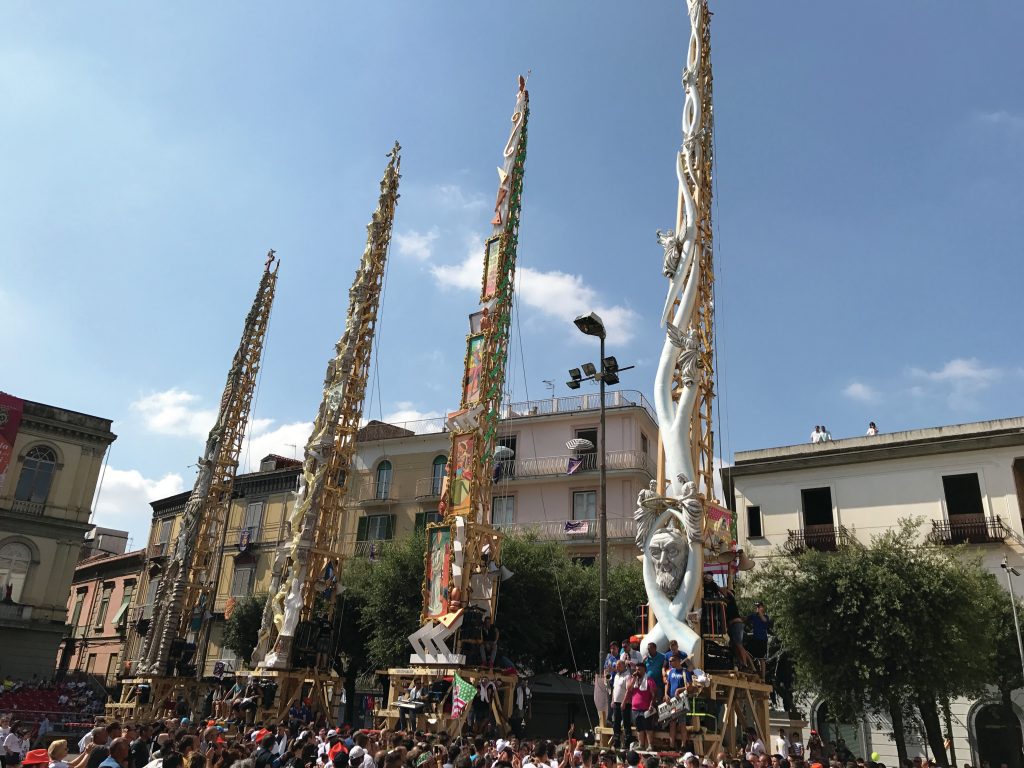
How would you characterize the Catholic masculinity of the Giglio?
From the outside, on the street, the dance of the Giglio is all brawn, muscles, and sweat. But once you start spending time with these men and learning all of the things they do backstage to prepare for the dance, all sorts of masculinities open up that involve different kinds of labor and service. Not everyone is lifting the Giglio: Some are also working in the basement, using a table saw to build and repair the Giglio. That of course is also very stereotypically masculine. But then there are others who are making saints or angels out of papier-mâché, crafting wings, a crown, or the Christ child with their hands. And then taking care to paint it, to make sure that others can read it a certain way. These are all acts of care and tenderness.
In my book, I talk about another man in the parish who sees fundraising for the church as his life’s work. This man never gets under the poles of the Giglio, but he is instrumental to helping the feast happen behind the scenes. There’s another man who’s good at IT and website design, so he manages the church’s website and sets up livestreams for the Masses.
All of these men are looking to give back to the church and to do good in the eyes of God. I think if we only look at the men carrying the Giglio, we lose sight of the other ways in which men are expressing deep love and care for their church and for the saints—ways that are accessible to them and that are not only about strength. There are so many ways men give themselves to their community that are not just typical “macho” masculine ways.
Does the festival connect these men with a larger Catholic community outside the parish?
There is definitely something about the feast that integrates men into a broader, more global Catholic community. For example, many of them travel to Nola together to witness the birthplace of this ritual. They don’t know anyone there, they don’t speak Italian, they have no shared geography, yet these men feel as if they can drop down in Nola and know the place and be a part of the Catholic community there.
Even though this is a very specific, extra liturgical event, I think it shows us the way embodied knowledge and bodily practices are so important in Catholicism. Sure, Catholicism is about creed, but it’s also about certain motions. We share these not only with people in our parish but also around the globe.
This article also appears in the July 2021 issue of U.S. Catholic (Vol. 86, No. 7, pages 20-24). Click here to subscribe to the magazine.
All Photos: Alyssa Maldonado-Estrada


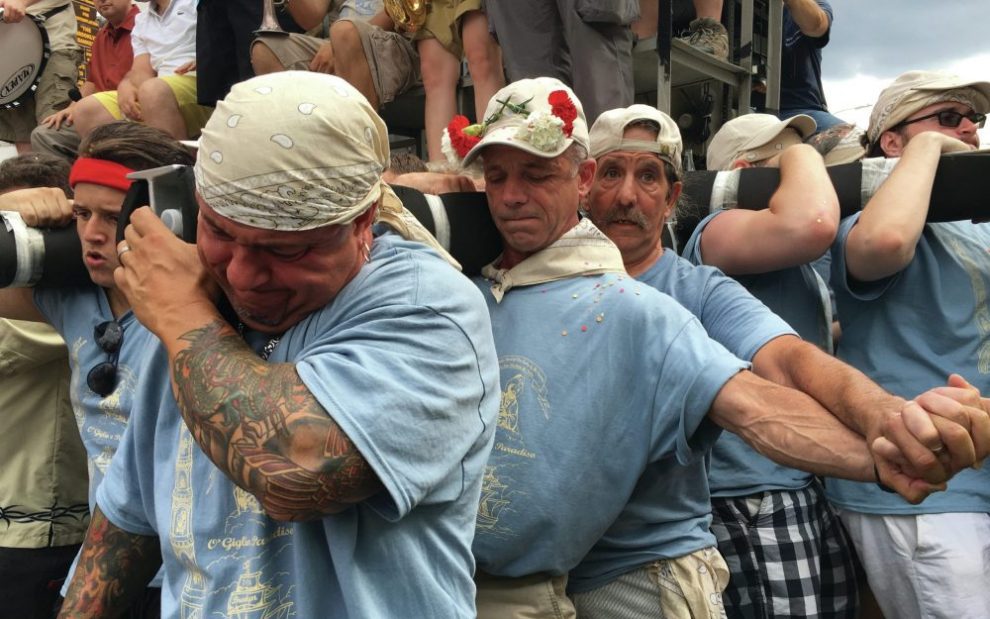



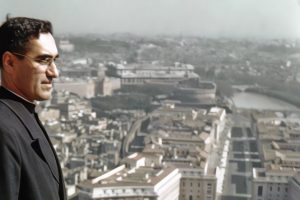






Add comment